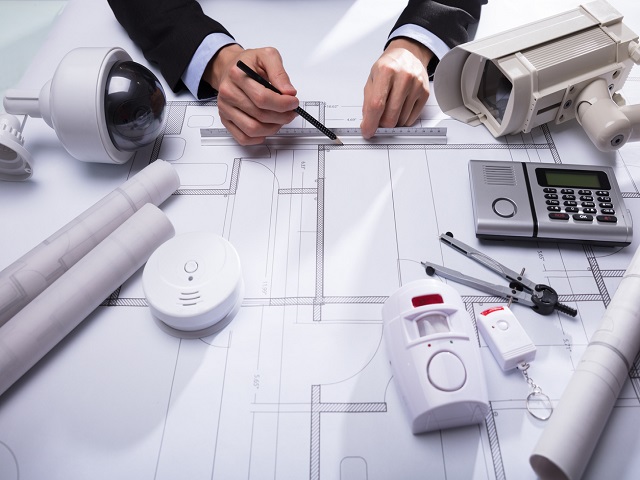Key Security Features Required for Access Control Systems
23 August 2023

When designing an access control system for a building, there are certain features that you need to ensure the system is secure and robust. After all, access control systems are critical components in the security arrangements for any building, helping to provide secure protection to both the building, people and contents within.
So what are the essential security features you should ensure are built-into your access control system. Here are some of the most commonly required.
Authentication Mechanisms
Authentication is the cornerstone of any access control system. It is the process by which individuals are identified and verified before granting access. The authentication process works by way of a credential assigned to an individual which is stored within an access control database. When an individual presents their credential, the access control software checks the credential to the database record and either grants or denies access. Effective authentication mechanisms include:
- Access Control Cards: these are physical plastic cards with built-in electronics to store an assigned credential. Sometimes referred to as ‘smart cards’, they require insertion or placing close to (proximity) a card reader for their credential to be read. The cards often incorporate encryption, enhancing security against cloning or tampering.
- Biometrics: these fingerprint, facial, and retinal scans, and provide high-level security relying on unique physical characteristics. Biometrics are difficult to forge, making them a formidable barrier against unauthorised access and require a suitable biometric reader.
- Passwords and PINs: while not as secure as smart cards or biometrics, passwords and Personal Identification Numbers (PINs) are still widely used for their simplicity. However, they should be complex and regularly updated to minimise potential vulnerabilities.
Some access control systems offer multi-factor authentication (MFA). In this instance an access control card with a PIN code could be used.
Authorisation Policies
Once authentication is successful, an access control system must enforce authorisation policies. Authorisation specifies what actions or resources a user can access. Typical considerations include:
- Role-Based Access Control (RBAC): assigns permissions based on roles within an organisation. Users are granted access according to their job functions, reducing the risk of privilege escalation.
- Attribute-Based Access Control (ABAC): evaluates multiple attributes such as user roles, time, location, and device characteristics to make access decisions. This fine-grained approach enhances security by allowing dynamic access control.
- Access Revocation: timely revocation of access rights for employees or users who no longer require them is crucial. This minimises the potential for unauthorised access due to forgotten permissions.
Encryption and Data Protection
Protecting data during transmission and storage is paramount. Access control systems should implement robust encryption mechanisms.
Audit Trails and Monitoring
Continuous monitoring and auditing access activities are essential for detecting suspicious behaviour and ensuring accountability:
- Event Logging: access control systems should maintain detailed logs of access attempts, including user identities, timestamps, and the resources accessed. These logs serve as valuable forensic tools.
- Real-time Alerts: automated alerts can notify security personnel of unusual or unauthorised access attempts in real time, allowing for immediate response.
Physical Security Integration
Access control systems control physical entry points. These can include doors, gates, turnstiles, barriers and lift doors. Other systems that can be integrated with an access control system to further improve security include:
- Surveillance Cameras: placed at access points to provide visual confirmation of identity of individuals within a specific doorway area. For example, the EntroWatch access control system can provide camera video feeds and the recording/playback of specific camera footage against controlled entry point incidents.
- Perimeter Intrusion Detection Systems (PIDS): these help to protect the outer boundaries including fences and gates, to a building and its wider area. A PIDS can detect physical breaches, cuts and climbs as well as tampering, and generate alarms.
User Training and Awareness
No access control system is effective without user understanding and compliance:
- Training Programs: employees and users should receive training on security best practices, including the proper use of authentication methods and the importance of maintaining strong passwords.
- Security Awareness: regular communication and reminders about security policies and procedures help reinforce good security habits.
Scalability and Flexibility
Security needs evolve over time. Access control systems should be scalable and flexible to accommodate changing requirements:
- Scalability: the system should easily adapt to accommodate new users, devices, or access points without compromising security.
- Integration Capabilities: the ability to integrate with other security systems, such as identity management platforms or Single Sign-On (SSO) solutions, enhances overall security posture.
In conclusion, an access control system is a vital component of a modern security solution. To effectively protect a property, people and contents, it must incorporate a comprehensive set of security features, including robust authentication, fine-grained authorisation, encryption, auditing, physical security integration, user training, and scalability. By prioritising these features, organisations and individuals can establish a strong defence against unauthorised access and potential security breaches, ensuring the safety and security of a building, the perimeter and specific building areas, and the people, assets and contents within.
